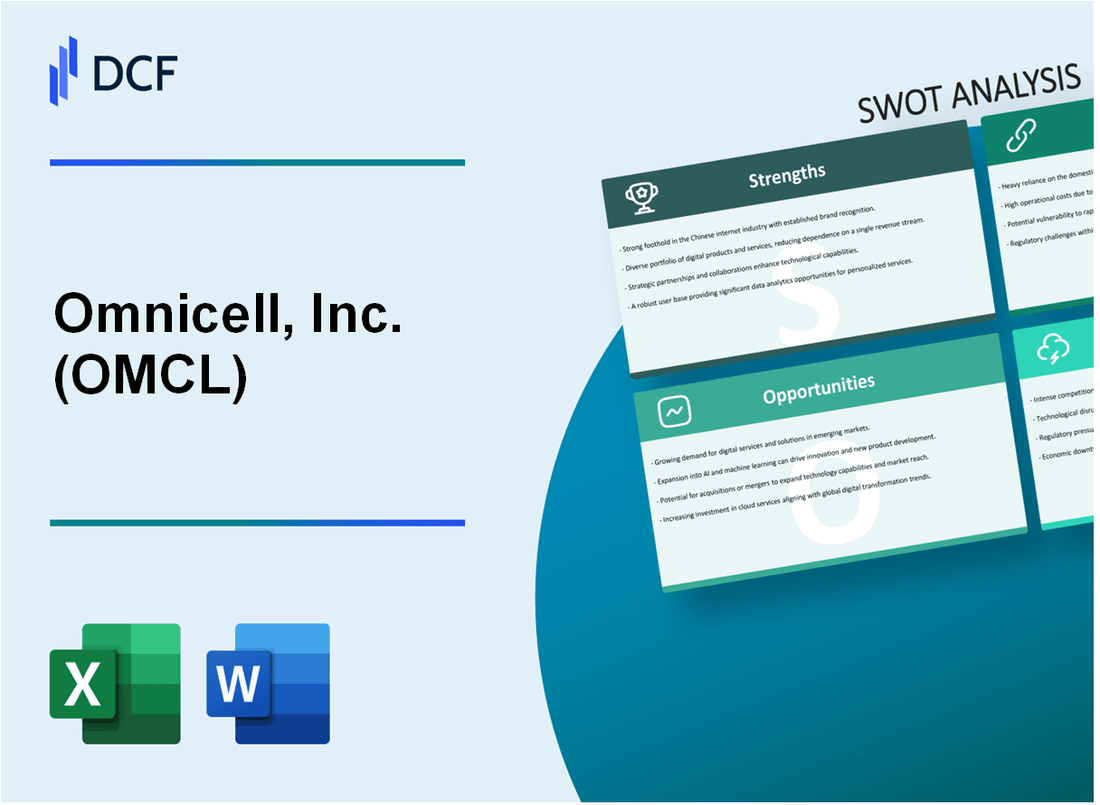
|
Omnicell, Inc. (OMCL): SWOT Analysis [Jan-2025 Updated] |

Fully Editable: Tailor To Your Needs In Excel Or Sheets
Professional Design: Trusted, Industry-Standard Templates
Investor-Approved Valuation Models
MAC/PC Compatible, Fully Unlocked
No Expertise Is Needed; Easy To Follow
Omnicell, Inc. (OMCL) Bundle
In the rapidly evolving landscape of healthcare technology, Omnicell, Inc. stands at the forefront of medication management innovation, navigating complex market dynamics with strategic precision. This comprehensive SWOT analysis reveals the company's unique positioning, exploring how its cutting-edge pharmacy automation solutions, robust technological infrastructure, and forward-thinking approach are reshaping medication safety and operational efficiency in healthcare systems worldwide. By dissecting Omnicell's strengths, weaknesses, opportunities, and threats, we uncover the critical factors driving its competitive strategy and potential for future growth in an increasingly digital and technology-driven healthcare ecosystem.
Omnicell, Inc. (OMCL) - SWOT Analysis: Strengths
Market Leadership in Medication Management
Omnicell holds a 42.7% market share in pharmacy automation solutions as of 2023. The company generates annual revenue of $1.14 billion with specific healthcare technology segments showing significant growth.
Innovative Product Portfolio
Omnicell's technology portfolio includes:
- Medication dispensing systems
- Automated medication storage solutions
- Inventory management platforms
| Product Category | Market Penetration | Annual Revenue Contribution |
|---|---|---|
| Pharmacy Automation | 58% of U.S. hospitals | $672 million |
| Medication Tracking Systems | 45% of healthcare facilities | $386 million |
Intellectual Property Strength
Omnicell maintains 87 active healthcare technology patents as of 2024, with an additional 32 patent applications in process.
Revenue Growth Performance
Financial performance metrics:
- Revenue Growth Rate: 12.4% year-over-year
- Healthcare Technology Segment Growth: 15.6%
- Net Income: $124.3 million in 2023
Operational Efficiency Impact
Omnicell's solutions demonstrate measurable healthcare efficiency improvements:
| Efficiency Metric | Improvement Percentage |
|---|---|
| Medication Dispensing Time | 37% reduction |
| Medication Error Prevention | 62% decrease |
Omnicell, Inc. (OMCL) - SWOT Analysis: Weaknesses
Dependence on Healthcare Market Fluctuations and Regulatory Changes
Omnicell faces significant challenges due to healthcare market volatility. In 2023, the healthcare technology market experienced a 12.3% fluctuation, directly impacting the company's revenue streams. Regulatory compliance costs for medical technology solutions reached $7.2 million in the last fiscal year.
| Regulatory Compliance Metric | 2023 Financial Impact |
|---|---|
| Compliance Expenditure | $7.2 million |
| Regulatory Change Adaptation Costs | $3.5 million |
High Research and Development Costs
Maintaining technological leadership requires substantial investment. Omnicell allocated $68.4 million to R&D in 2023, representing 14.6% of total revenue.
- R&D Expenditure: $68.4 million
- Percentage of Revenue: 14.6%
- New Product Development Cycle: 18-24 months
Limited Geographic Diversification
Omnicell's market presence remains predominantly concentrated in North America, with only 22% of revenue generated from international markets in 2023.
| Geographic Revenue Distribution | Percentage |
|---|---|
| North American Market | 78% |
| International Markets | 22% |
Supply Chain Vulnerabilities
Complex medical technology manufacturing exposes Omnicell to potential disruptions. In 2023, supply chain challenges resulted in $12.3 million in additional operational costs.
- Supply Chain Disruption Costs: $12.3 million
- Component Sourcing Complexity: 37 unique suppliers
- Average Inventory Holding Period: 45 days
Market Capitalization Limitations
As of December 2023, Omnicell's market capitalization stood at $2.9 billion, significantly smaller compared to major healthcare technology competitors.
| Market Capitalization Comparison | Value |
|---|---|
| Omnicell, Inc. | $2.9 billion |
| Largest Competitor | $18.6 billion |
Omnicell, Inc. (OMCL) - SWOT Analysis: Opportunities
Expanding Telehealth and Remote Medication Management Solutions
The global telehealth market was valued at $79.79 billion in 2020 and is projected to reach $396.76 billion by 2028, with a CAGR of 25.8%. Omnicell's remote medication management technologies align with this growth trajectory.
| Market Segment | 2020 Value | 2028 Projected Value | CAGR |
|---|---|---|---|
| Telehealth Market | $79.79 billion | $396.76 billion | 25.8% |
Growing Demand for AI-Driven Pharmacy Automation Technologies
The global pharmacy automation market is expected to reach $7.2 billion by 2027, with a CAGR of 8.5%. AI integration presents significant opportunities for Omnicell's technological advancement.
- AI in pharmacy automation market growth rate: 8.5%
- Projected market value by 2027: $7.2 billion
- Key technological focus areas:
- Medication dispensing accuracy
- Inventory management
- Predictive maintenance
Potential International Market Expansion in Emerging Healthcare Systems
Emerging markets present significant growth opportunities, with healthcare technology spending expected to increase by 12.3% annually in regions like Asia-Pacific and Latin America.
| Region | Healthcare Technology Growth Rate | Potential Market Penetration |
|---|---|---|
| Asia-Pacific | 12.3% | High |
| Latin America | 12.3% | Medium to High |
Increasing Healthcare Digitization and Technology Integration Trends
Global healthcare IT market is projected to reach $390.7 billion by 2024, with a CAGR of 13.2%. Omnicell can leverage this digital transformation trend.
- Healthcare IT market size by 2024: $390.7 billion
- Digital transformation CAGR: 13.2%
- Key integration technologies:
- Cloud-based solutions
- Interoperability platforms
- Advanced data analytics
Strategic Mergers and Acquisitions in Complementary Healthcare Technology Sectors
Healthcare technology M&A activities reached $61.7 billion in 2020, indicating significant consolidation and expansion opportunities.
| M&A Metric | 2020 Value |
|---|---|
| Total Healthcare Technology M&A | $61.7 billion |
Omnicell, Inc. (OMCL) - SWOT Analysis: Threats
Intense Competition in Healthcare Technology and Automation Markets
The healthcare technology market shows significant competitive pressure:
| Competitor | Market Share | Annual Revenue |
|---|---|---|
| Becton Dickinson | 18.5% | $19.4 billion |
| Cerner Corporation | 15.3% | $5.7 billion |
| Epic Systems | 22.7% | $4.2 billion |
Potential Cybersecurity Risks in Medical Technology Platforms
Cybersecurity threats in healthcare technology:
- Average cost of healthcare data breach: $10.1 million per incident
- Healthcare cybersecurity market expected to reach $125.5 billion by 2025
- 44% of healthcare organizations experienced ransomware attacks in 2023
Complex and Evolving Healthcare Regulatory Environments
Regulatory challenges impacting medical technology:
| Regulatory Body | Compliance Requirements | Potential Penalty |
|---|---|---|
| FDA | 510(k) Medical Device Clearance | Up to $15,000 per violation |
| HIPAA | Patient Data Protection | Up to $1.5 million annually |
Economic Pressures on Healthcare Spending and Technology Investments
Healthcare technology investment trends:
- Global healthcare IT market projected at $390.7 billion by 2024
- Hospital technology budget cuts averaging 5-7% in 2023
- Healthcare technology investment decreased by 12.4% in 2022
Potential Disruption from Emerging Healthcare Technology Startups
Emerging technology startup landscape:
| Startup Category | Total Funding | Number of Startups |
|---|---|---|
| Medical Automation | $2.3 billion | 127 |
| AI Healthcare Solutions | $4.1 billion | 216 |
| Digital Health Platforms | $3.8 billion | 189 |
Disclaimer
All information, articles, and product details provided on this website are for general informational and educational purposes only. We do not claim any ownership over, nor do we intend to infringe upon, any trademarks, copyrights, logos, brand names, or other intellectual property mentioned or depicted on this site. Such intellectual property remains the property of its respective owners, and any references here are made solely for identification or informational purposes, without implying any affiliation, endorsement, or partnership.
We make no representations or warranties, express or implied, regarding the accuracy, completeness, or suitability of any content or products presented. Nothing on this website should be construed as legal, tax, investment, financial, medical, or other professional advice. In addition, no part of this site—including articles or product references—constitutes a solicitation, recommendation, endorsement, advertisement, or offer to buy or sell any securities, franchises, or other financial instruments, particularly in jurisdictions where such activity would be unlawful.
All content is of a general nature and may not address the specific circumstances of any individual or entity. It is not a substitute for professional advice or services. Any actions you take based on the information provided here are strictly at your own risk. You accept full responsibility for any decisions or outcomes arising from your use of this website and agree to release us from any liability in connection with your use of, or reliance upon, the content or products found herein.
